
Westland Gate (also known as the Johnson Gates) is a pair of fountains that borders the Back Bay Fens at the end of Westland Avenue in Boston.

Westland Gate (also known as the Johnson Gates) is a pair of fountains that borders the Back Bay Fens at the end of Westland Avenue in Boston.
Westland Gate was designed by Guy Lowell, architect of the Boston's Museum of Fine Arts, and was built in 1902 and erected in 1905. The decorative bronze was produced by the Hecla Iron Works. The fountains were originally named the Johnson Memorial Fountain after a wealthy Bostonian, Jesse Johnson, whose widow, Ellen Cheney Johnson, donated money to erect them. The fountains consist of two large pillars caped with bronze frieze panels made of granite and Tennessee marble flanking the street with four bronze lions heads near their bases that originally spouted water. [1]
The fountains were first restored in 1980. [2] It appears that the 1980 restoration involved either sandblasting or honing to address inconsistencies in the stone, as well as application of a protective treatment (to resist graffiti) using Browne Fund money. [3] The gates were rededicated in a ceremony that followed this restoration in August 1980. The 1990 restoration involved cleaning of the marble, repointing and repair of cracks in the stone, application of protective treatment, and cleaning and repair of the metal components (decorative frieze, lion heads, and commemorative plaque). A new lighting system was proposed for the gates at this time, but seems never to have been installed. On May 4, 2008, a spokesperson for the Boston Parks Department stated that the "fountains are on a list of projects to be repaired". [4] However, over a year later, the fountains still remain in poor condition and are non-functional.
A new restoration effort spearheaded by the Fenway Civic Association (FCA) began in 2012, securing funding for conservation assessments, performed in October 2013. In 2013 the bronze elements were cleaned, repatinated, and treated with wax sealant. In 2014 Preservation Massachusetts designated the Johnson Memorial Gates as one of the Massachusetts Most Endangered Historic Resources. [5] In 2015, grant funding from the Browne Fund restored the two horse troughs and provided weather tight covers on Hemenway Street. For fiscal year 2017 the city of Boston approved $820,000 for Johnson Memorial Gates monument conservation, accessibility upgrades, and landscape rehabilitation. These funds were complemented by a $67,985 grant administered by the Boston Planning and Development Agency in 2017. [6] For fiscal year 2019, the city of Boston approved the increase of project funds for the monument and surrounding parkland to $1,002,000; these funds were complemented by a Community Preservation Act pilot grant awarded to FCA in June, 2018. [7]

Buckingham Fountain is a Chicago Landmark in the center of Grant Park, between Queen's Landing and Ida B. Wells Drive. Dedicated in 1927 and donated to the city by philanthropist Kate S. Buckingham, it is one of the largest fountains in the world. Built in a rococo wedding cake style and inspired by the Latona Fountain at the Palace of Versailles, its design allegorically represents nearby Lake Michigan. The fountain operates from May to mid-October, with regular water shows and evening colored-light shows. During the winter, the fountain is decorated with festival lights.

The Back Bay Fens, often called The Fens, is a parkland and urban wild in Boston, Massachusetts, in the United States. It was established in 1879. Designed by Frederick Law Olmsted to serve as a link in the Emerald Necklace park system, the Fens gives its name to the Fenway-Kenmore neighborhood.

The Public Garden, also known as Boston Public Garden, is a large park in the heart of Boston, Massachusetts, adjacent to Boston Common. It is a part of the Emerald Necklace system of parks, and is bounded by Charles Street and Boston Common to the east, Beacon Street and Beacon Hill to the north, Arlington Street and Back Bay to the west, and Boylston Street to the south. The Public Garden was the first public botanical garden in America.
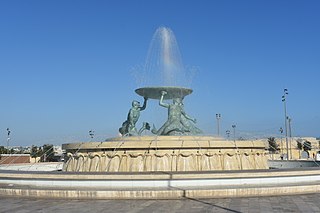
The Tritons’ Fountain is a fountain located just outside the City Gate of Valletta, Malta. It consists of three bronze Tritons holding up a large basin, balanced on a concentric base built out of concrete and clad in travertine slabs. The fountain is one of Malta's most important Modernist landmarks.

Fenway, commonly referred to as The Fenway, is a mostly one-way, one- to three-lane parkway that runs along the southern and eastern edges of the Back Bay Fens in the Fenway–Kenmore neighborhood of Boston, in the east-central part of the U.S. state of Massachusetts. As part of the Emerald Necklace park system mainly designed by Frederick Law Olmsted in the late 19th century, the Fenway, along with the Back Bay Fens and Park Drive, connects the Commonwealth Avenue Mall to the Riverway. For its entire length, the parkway travels along the Muddy River and is part of the Metropolitan Park System of Greater Boston. Like others in the park system, it is maintained by the Massachusetts Department of Conservation and Recreation.

Fountain of Time, or simply Time, is a sculpture by Lorado Taft, measuring 126 feet 10 inches (38.66 m) in length, situated at the western edge of the Midway Plaisance within Washington Park in Chicago, Illinois, in the United States. The sculpture is inspired by Henry Austin Dobson's poem "Paradox of Time". Its 100 figures passing before Father Time were created as a monument to the 100 years of peace between the United States and the United Kingdom following the Treaty of Ghent in 1814. Father Time faces the 100 from across a water basin. The fountain's water was turned on in 1920, and the sculpture was dedicated in 1922. It is a contributing structure to the Washington Park United States Registered Historic District, which is a National Register of Historic Places listing.

Lynnewood Hall is a 110-room Neoclassical Revival mansion in Elkins Park, Montgomery County, Pennsylvania. Currently undergoing renovations after sitting nearly vacant for years, it was designed by architect Horace Trumbauer for industrialist Peter A. B. Widener and built between 1897 and 1900. Considered the largest surviving Gilded Age mansion in the Philadelphia area, it housed one of the most important Gilded Age private art collections of European masterpieces and decorative arts, which had been assembled by Widener and his younger son, Joseph E. Widener.

Katharine Lane Weems born Katharine Ward Lane was an American sculptor famous for her realistic portrayals of animals.

The Middlesex County Courthouse is a historic courthouse building in East Cambridge, Massachusetts. It was initially designed in 1814-1816 by noted architect Charles Bulfinch (1763–1844), and subsequently enlarged in 1848 by Ammi B. Young.
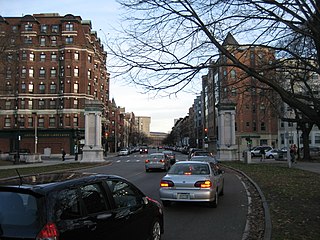
The Fenway-Boylston Street District is a historic district encompassing a series of predominantly residential buildings lining The Fenway in the Fenway–Kenmore of Boston, Massachusetts. Developed beginning in the 1890s, the area is emblematic of Boston's upper-class residential development of the period, with architect-designed houses built for some of the city's leading families. The district was listed on the National Register of Historic Places in 1984.

Wright Memorial Library, more commonly known as the "Wright Building," is a historic library at 147 St. George Street in Duxbury, Massachusetts.
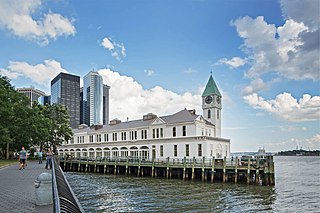
The New York Landmarks Conservancy is a non-profit organization "dedicated to preserving, revitalizing, and reusing" historic structures in New York state. It provides technical and financial skills to owners of historic properties. Since its founding, the conservancy has provided more than $60 million in grants and loans.

Strand Theatre is a restored vaudeville house located in Uphams Corner in Dorchester, Boston, Massachusetts. It is owned by the City of Boston and managed by the Mayor's Office of Arts and Culture.
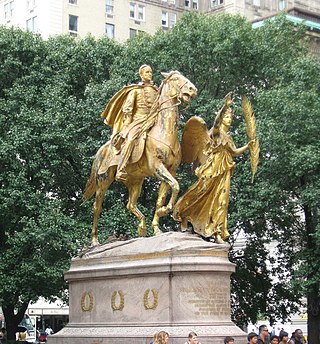
Grand Army Plaza is a square at the southeast corner of Central Park in Manhattan, New York City, at the intersection of Fifth Avenue and Central Park South, covering two blocks on the west side of Fifth Avenue between 58th and 60th Streets. It contains an equestrian statue of William Tecumseh Sherman on its northern half and the Pulitzer Fountain on its southern half.

The Nathaniel Wheeler Memorial Fountain is located in Bridgeport, Connecticut at the intersection of Fairfield and Park avenues. The fountain was built in 1912–1913 and was added to the National Register of Historic Places on April 4, 1985. The fountain consists of four elements: a central bronze figure of a mermaid rising out of a polished granite pool and three individually ornamented polished granite watering troughs at the angles of the triangular parcel of land raised above the street. The mermaid holds aloft a lamp in her right hand, and a baby in her left. Its tail is wrapped around two dolphins, and the faces of four babies appear in relief around the rim of the pool. The three surrounding troughs are each adorned with individualized figures.

Ellen Cheney Johnson was an American prison reformer. She founded the New England Women's Auxiliary Association to the United States Sanitary Commission, worked with homeless and vagrant women after the Civil War through the Dedham Asylum for Discharged Female Prisoners, and served as superintendent of the Massachusetts Reformatory Prison for Women at Framingham.

The Friends of the Uffizi Gallery was established in 2006 in Palm Beach, Florida as the United States "sister" organization to the Amici degli Uffizi in Florence, Italy, which was founded by a group of concerned people in response to the terrorist bombing of the Uffizi Gallery in May 1993 that damaged several artworks and portions of the museum. The Friends of the Uffizi Gallery and the Amici degli Uffizi directly support the Uffizi Gallery by helping build awareness of the museum and its cultural heritage and by raising funds for acquisitions, preservation, restorations, temporary exhibitions, and educational programming.

The Friends of the Public Garden (FOPG) is a non-profit organization founded in 1970 for the protection and preservation of the Boston Common, Public Garden, and Commonwealth Avenue Mall. Located in Boston, Massachusetts, the Friends of the Public Garden works with the Boston Parks Department to care for the trees, sculptures, gardens, and grounds in the three parks. The organization is supported by a full-time staff, board of directors, council, volunteers, and over 2,500 members. The group aims to care for the Boston Common, Public Garden, and Commonwealth Avenue Mall so that the parks can be fully enjoyed by current and future locals and visitors.
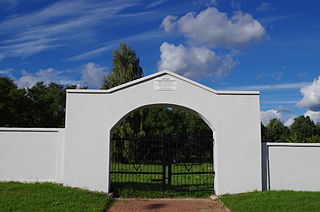
The Jewish Cemetery in Wschodnia street, Białystok was created in 1891, after the closure of the old cemetery, the Rabbinic Cemetery, on Kalinowski Street. The Jewish cemetery is a listed heritage monument.

The Erskine Memorial Fountain is a public fountain in Grant Park of Atlanta, Georgia, United States. Designed by J. Massey Rhind in honor of John Erskine, it was the first public fountain in Atlanta. The fountain was built in 1896 and moved to its current location in 1912.
![]() Media related to Westland Gate at Wikimedia Commons
Media related to Westland Gate at Wikimedia Commons